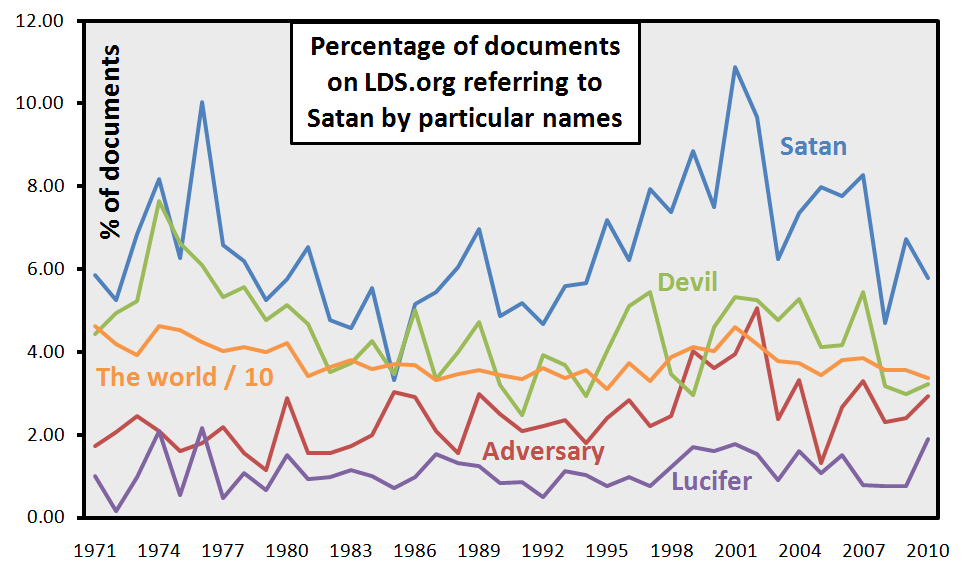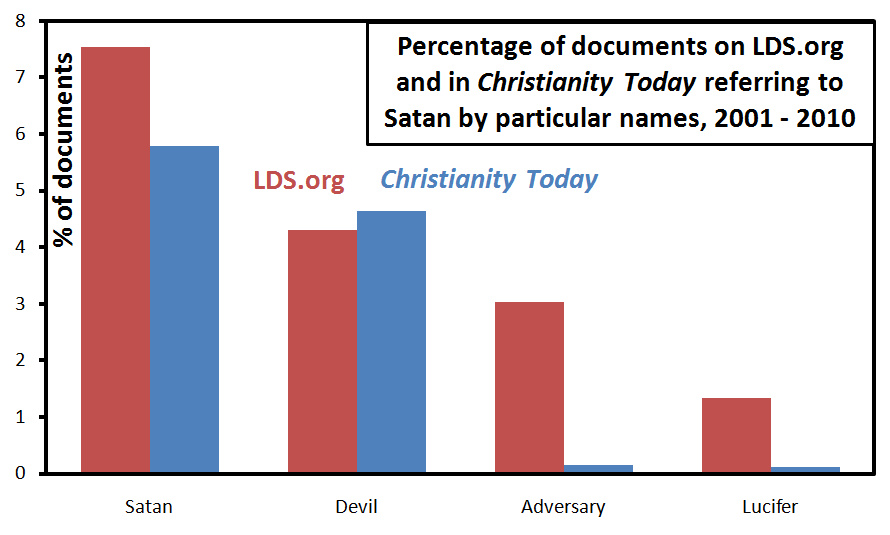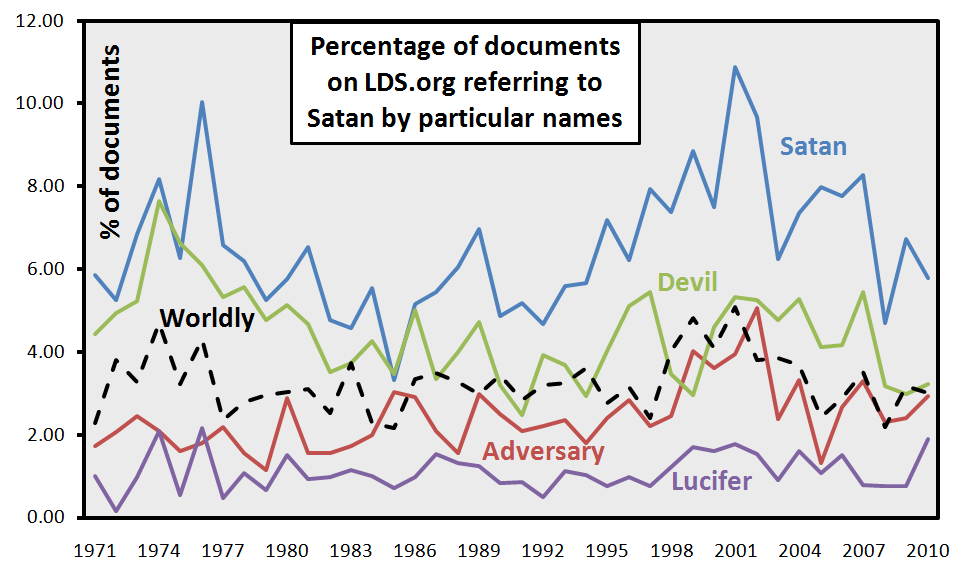What name do Mormons most often use to refer to Satan? A few months ago, Julie M. Smith suggested in a post at T&S that we might be cutting back on naming him specifically as being responsible for evils in favor of blaming “the world.”
Naturally, I wanted to check out her claim by searching LDS.org. Not because I doubt her–her conclusion actually matches my experience too–but because I often have fun looking at such things. Unfortunately, I found that searching LDS.org for the phrase “the world” turns up hundreds of matches, most of which are not references to the evils of the world in the sense Julie was talking about. So, since I was looking for a quick-and-dirty solution that allowed me to just count results rather than an in-depth one that actually required me to comb through and look at them, I decided to look only at usage of names that are unambiguously applied to Satan.
Here are the names I came up with:
- Satan
- Devil
- Lucifer
- Adversary
That’s it. I know there are other familiar names for Satan–Beelzebub, for example–but I don’t think these get used much in LDS discourse. (Please correct me in the comments if there are other commonly-used names I’ve missed.)
First, I looked at changes over time in usage of these four names in documents on LDS.org. Here’s a graph showing their usage from 1971-2010.
“Satan” has clearly been the most popular name, followed by “Devil,” “Adversary,” and “Lucifer.” The ordering of these has remained almost completely consistent across the last 40 years, although the differences haven’t always been the same. For comparison in the graph, I also threw in “the world,” but divided by 10 so its scale would fit in with the other names. Note that even the most popular name, “Satan,” only appears in about 10% of all documents in its peak years. “The world,” on the other hand, appears in over 40% of documents.
For each of the four names, I also used permutation tests to test whether there was an increase or decrease across the entire 40-year period, as well as whether there was an increase or decrease within each 10-year period (i.e., 1971-1980, 1972-1981, etc.). The only trend I found that was steep and consistent enough to not likely be a chance effect1 was for “Adversary.” Its usage increased by an average of .03% (i.e., .0003) of articles per year, or in other words, .3% per decade, or 1.2% across the entire 40 years. Not a whole lot. Looking at individual decades, I found the following: for “Satan,” a decline from 1976 to 1985 and increases from the early 1990s to the early 2000s; for “Devil,” declines from the mid-1970s to the mid-1980s; for “Lucifer,” an increase from 1992 to 2001.
In a similar post a couple of years ago about usage of names of Jesus, I compared LDS usage to evangelical Christian usage by looking for the same names in Christianity Today. I thought a similar comparison might be interesting for names for Satan. I compared the percentage of documents in which each of the four names was used on LDS.org and in articles in Christianity Today in the past decade (2001-2010). Here is a graph showing the results:
It’s interesting that “Satan” is #1 and “Devil” is #2 for both LDS.org and Christianity Today, but after that, Christianity Today is pretty much done, while the LDS documents still have quite a few references to “Adversary” and “Lucifer.” (I realize this difference may be a result of my lack of familiarity with evangelicals’ preferred names for “Satan.”) It appears that Mormon publications may make both more total references to Satan, and references using more different names for him.
I don’t have any grand conclusions. I’d love to hear your thoughts on the question of names for Satan.
Update: Brian-A (comment #3) suggested some good alternative terms to get at usage of “the world.” Based on his suggestion, I gathered data for the term “worldly” and added data on it to the first graph. Although they may not be directly comparable, it falls behind only “Satan” and “Devil.”
I also did permutation tests to see if there were trends in usage of “worldly.” There was not an overall trend across the 40 years; the only decade within which there was a trend was 1999 – 2008, during which there was a decline.
__________________________
1In other words, these were the statistically significant results. I used alpha (Type I error rate, or false alarm rate) = .005.



It surprises me that “Adversary” is not higher on the scale for GC–I would have thought that would at least be switched with “devil.”
I don’t hear much talk about the devil in local meetings. It is always interesting to note the differences in hot topics between GC and local lessons and talks. One of my friends was pulling out her hair at how obsessed her ward is with a years’ supply and R-rated movies. It forced her to search LDS.org and arm herself with actual data on when and how often those topics are actually addressed in GC, which is not anything like her ward. I’m not sure that information will make her feel any better–likely just more frustrated at the disparity.
I think I may be a witch: I was thinking about that post just yesterday and wishing you would crunch the numbers.
And here it is.
I tried decade-by-decade searches on lds.org for Babylon, “peer pressure”, and worldly. Babylon and peer pressure are used about as frequently as Lucifer, but Babylon is falling. Use of “worldly” is more common (competitive with Adversary) and increasing (224 raw search results for 1981-1990, 324 for 1991-2000, and 350 for 2001-2010).
ESO, interesting point about the general-local disparity. I would love to have measures of what topics are addressed a lot in particular places. That would make for some fascinating comparisons. Like you could look at how long things took to filter down from a general to a local level, or how many times they had to be addressed first, or whether the process ever worked in reverse. Unfortunately, I’m far too lazy to gather data even on my own ward.
Also, when I first read that your friend was frustrated about “a years’ supply and R-rated movies” I read it as “a year’s supply OF R-rated movies” and I thought she must live in a really unusual ward!
Julie, I feared as much! I should know by now when a Jedi mind trick is being used on me. 🙂
Brian, good thinking! Thanks for running the numbers. Your results definitely looks to match Julie’s hypothesis.
Great post. I always love your statistics. I’m surprised that we talk about Satan more than the evangelicals. When I was on my mission (8 years ago in North Carolina), I barely heard anything from fellow church members about Satan, but I heard plenty from the non-LDS people.
When my husband, who isn’t LDS, does his best General Conference spoofs, they always, always, have several mentions of THE ADVERSARY(cue lightning). It seems the data bears out his perspective that the term is a ‘Mormon’ thing.
Very interesting! Thanks for doing this.
Lucifer mens “light bearer, bringer of light” and is the Latin translation of the Greek phosphoros. In classical literature these terms were used to refer to Venus as the morning star. As the evening star, Venus was noctifer (night bearer, bringer of night), or such terms as Hesperus, Vesper, or Nocturnus. When used as a personification, Lucifer was the son of Astraeus and Aurora, and the father of Cyx, Daedalion and the Hesperides. The word Lucifera is used for several goddesses of light: Diana (Artemis), Aurora and Hecate.
The word lucifer enteres Christian traditions when Jerome used it in his Vultgate to translate the Hebrew expression helel ben-shachar Day Star, son of Dawn from Isaiah 14:12. Although in context this was talking about the king of Babylon, the passage was applied symbolically to the myth of the fall of Satan.
The King James Version like the Vulgate uses the word lucifer in its translation of the Isaiah passage, whereas virtually all modern translations do not. So although the equation of Lucifer with Satan is embedded in hoary Christian tradition, I’m guessing that the continued Mormon usage of the KJV might play a role in our more prominent usage of the name Lucifer for the Devil.
Two reasons why Lucifer might be more popular in Mormon texts are: 1) the use of that name in the BoM and 2) the assumption that Lucifer is the pre-mortal (or real) name of Satan.
The term “Lucifer” also emphasizes that he is in need of some restraint.
.
Ohhhhhh, I so want to plug Monsters & Mormon right now but I can’t even tell you why…..
Based on Brian-A’s suggestion, I’ve updated the post to include a new graph that has data for “worldly” as a way of getting as usage of “the world.”
Great post.
What about Mammon? Perhaps that only comes up in the scripture- God and Mammon. I”m sure it’s not as popular as Satan.
This post makes me want to watch Mr. Diety again. . .
*make that Deity.
I love how the bloggernacle constantly teaches me things I can never tell anyone about for fear of either confusion or retribution. Special thanks to Julie, Kevin, and naturally, Ziff.